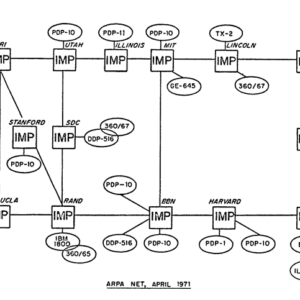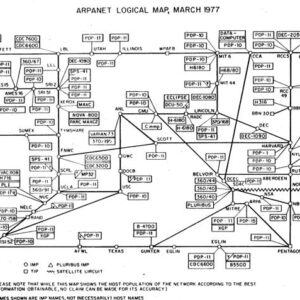Editor’s Note: Welcome to our weekly Reality Check column where C-level executives and advisory firms from across the mobile industry share unique insights and experiences.
DARPA, NSF and the commercialization of the Internet
With the president’s support for increased regulation now publicly known (see the corresponding Washington Post article on how this scuttled a near-term deal), I think it’s worth two columns to discuss practical ways to resolve two critical elements of the net neutrality debate: a) interconnection agreements; and b) paid prioritization.
The Internet was not invented in Silicon Valley by Apple, Cisco, Facebook, Uber, Netflix or Google. It was born out of the efforts of the Defense Advanced Research Projects Agency, an organization established by President Dwight Eisenhower in 1958. While it would require the rest of the column to outline the series of events that took place, it is interesting to note that IBM belittled the idea of the “Internet” in the 1960s, and that AT&T at that time had no commercially available “long lines” to handle Internet networking. Here are pictures of the 1971 and 1977 DARPAnet nodes:
Despite repeated efforts by Sen. Mike Mansfield (D.-Mt.) to curb DARPA’s efforts, the agency’s network lived on and made its next major leap with the development of transmission connect protocol/Internet protocol version 4 in 1982 and 1983. At this point, TCP/IP v4 became the standard for all military networking and would stand as the standard for more than 20 years. The launch of NSF Net in 1986 quintupled the number of Internet nodes, paving the way for the invention of the World Wide Web. The first commercially available Internet offerings did not appear until the mid-1990s, when the National Science Foundation ended its sponsorship of the Internet backbone.
Without the government’s sponsorship (and especially that of the defense and academic computer science communities), there would be no Twitter, Google, Netflix, Groupon, etc. However, without commercialization, the Internet would have been a costly private network (and there would have been no iPhone).
Bottom line: The Internet was a government invention in the 1970s and 1980s, but commercialized and financially sustained through entrepreneurs in the 1990s and beyond.
Connecting networks is a messy business
Transitioning from a government-run to a fully commercialized state has not been easy. Companies like BBN Planet, CERFNet, UUNet, SprintLink and Internet MCI carried traffic for emerging brand names through dial-up connections. Many other Internet backbone companies emerged during the “dot-com” boom. To connect server content to customers, all of these networks had to interconnect and, as a result, peering policies were developed.
Peering relationships have been the topic of debate since the development of commercialized Internet. The cartel forged by the original tier-one peers – who exchanged information between themselves at a settlement free rate but charged others for access – stood for nearly a decade. With the advent of large fiber backbones in the late 1990s, new networks emerged and faced a constant struggle to “break in” to the economic club. Genuity was acquired out of bankruptcy by Level3 in 2003. UUNet was acquired by MFS who was acquired by WorldCom and eventually Verizon Communications. Internet MCI was acquired by Cable & Wireless through the MCI/WorldCom divestiture and was eventually sold to Savvis, which is now a part of CenturyLink. SprintLink still exists largely as an IP backbone for Sprint’s wireless division. Tier-one IP status had cache and real economic value.
The concept of peering is not as straightforward as many have represented. The standard used in many agreements is called “hot-potato routing” which, as the name implies, involves handing off content to the destination IP provider as soon as possible. If the customer is in Tuscaloosa, Ala., and the desired server content is in Mountain View, Calif., under hot-potato routing, the Alabama Internet provider would be responsible for picking up the traffic at a peering point (e.g., in Palo Alto at the Palo Alto Internet exchange) and transiting it to Alabama. If the content is a Web page, it’s likely not a big deal, but if it’s a multigigabyte video, the type of routing makes a difference.
As the growth of YouTube and Netflix has proliferated, the argument of “where to interconnect” has intensified. Cable companies, which largely operate private backbones with leased or owned fiber, want to have Level3 or Cogent meet them as close to their facilities as possible. This practice is called “cold-potato routing” and is the framework for the termination of voice minutes between voice-over-IP and circuit-switched providers.
While Internet traffic continued to grow in the 2000s, it wasn’t until Netflix had accumulated a sufficiently large streaming library (roughly 2010) that cable companies (and Verizon and AT&T) began their demands for paid peering. This started a three-year feud between Level3 and Comcast that eventually resulted in a settlement.
While the details have not been disclosed, it’s likely that Level3 agreed to carry traffic farther into the network and have a handoff point closer to the customer. Using the Tuscaloosa example, instead of having Comcast transit traffic from Palo Alto to Tuscaloosa, the parties likely agreed to connect in Atlanta or Birmingham, Ala. At the same time, Netflix likely began to store some of its more popular content on servers in Atlanta to minimize their costs to Level3.
This solved some short-term problems, but Netflix continued to grow far faster than broadband subscribers as a whole. With Netflix continuing its rapid ascent – according to Sandvine, Netflix has grown from single-digit peak-period U.S. Internet traffic in 2010, to 35% today – many additional interconnection ports need to be added. If they are not added in a timely manner, service quality degrades.
Degradation applies not only to downloaded packets, but also to upload acknowledgements, or ACKs, that the download packets were received. Slow upstream acknowledgement will result in delays in release of additional downstream packets.
According to the Sandvine study cited above, 50% of today’s peak traffic (7-11 p.m.) comes from two sources: Netflix and YouTube. But traffic constraints are only going to get worse with the rise of HBO, CBS and Dish/Disney over-the-top services. Many in the Internet community have voiced concerns over the impact of increased congestion on interconnection points and have called on the government to act quickly.
To solve this problem, the Federal Communications Commission needs to do several things:
Separate interconnection policy from other parts of the current net neutrality debate (paid prioritization, open access, increased reporting, etc.): Interconnection policy involves establishing the correct size and speed to existing traffic, while many/most of the other issues involve the possible prioritization of traffic within a given port size.
In connection, determine whether there is enough bipartisan support to enact separate legislation: Nothing survives a court challenge like fresh legislation, and there are likely filibuster and veto-proof majorities to enact basic rules with Comcast, Level3, Google and Netflix support.
Determine the most sustainable business model (settlement-free vs. paid peering): While I, like most of you, support a settlement-free model, I can imagine a scenario where a paid-peering model – using a low, but fixed and predetermined rate based on the size of the broadband service provider – might spur additional last-mile investment.
For settlement-free models, the FCC should implement rules around:
• Server proximity to broadband service providers in the top 50 U.S. markets – e.g., Netflix must house the top programs on servers within certain fiber miles of Time Warner Cable’s head-end facilities.
• Forecasting requirements – and consequences for Google and Netflix if they over-forecast demand – for both upstream and downstream ports.
• Broadband service provider fulfillment requirements – a set number of calendar days to fulfill forecasted demand.
• Independent monitoring and expedited dispute resolution.
Form a timeline to include wireless providers in the equation: While there is a lot of emotion around the concept of paid prioritization, establishing long-needed interconnection rules represents the final step in transitioning from the DARPA/NSF academic model to a fully functional commercial model. The FCC plays an important watchdog role here, and needs to be clear how changes will improve the streaming experience.
Jim Patterson is CEO of Patterson Advisory Group, a tactical consulting and advisory services firm dedicated to the telecommunications industry. Previously, he was EVP – business development for Infotel Broadband Services Ltd., the 4G service provider for Reliance Industries Ltd. Patterson also co-founded Mobile Symmetry, an identity-focused applications platform for wireless broadband carriers that was acquired by Infotel in 2011. Prior to Mobile Symmetry, Patterson was president – wholesale services for Sprint and has a career that spans over 20 years in telecom and technology. Patterson welcomes your comments at jim@pattersonadvice.com and you can follow him on Twitter @pattersonadvice.
Photo copyright: pariwatlp / 123RF Stock Photo





